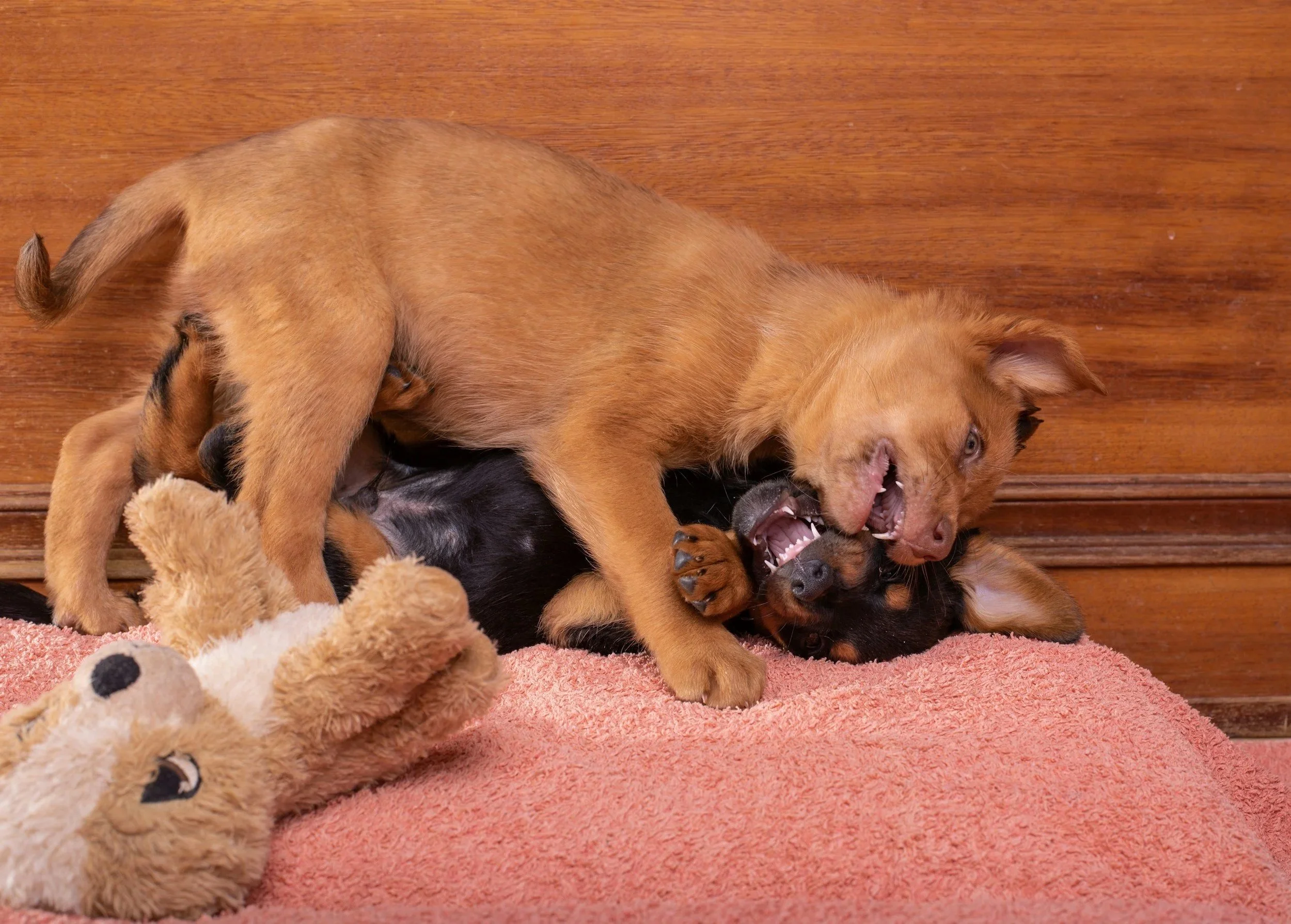As guardians, it is our responsibility to help puppies experience the world in safe, positive ways.
Read MorePuppies: Early Socialization Matters

As guardians, it is our responsibility to help puppies experience the world in safe, positive ways.
Read MoreAs guardians, it is our responsibility to help puppies experience the world in safe, positive ways.
Read More
by Jan Marinelli, Canine Coaching
Canine Infectious Respiratory Disease Complex (CIRDC), more familiarly known as kennel cough, is a highly contagious illness affecting the respiratory tract in dogs. Several different types of bacteria and viruses can contribute to CIRDC. Across the nation, a type of CIRDC that has been labeled, “the Mystery Respiratory Illness in Dogs”, has been on the rise. Symptoms of this CIRDC include a persistent cough, lethargy, poor appetite, weakness, runny eyes and nose, and difficulty breathing. Some affected dogs experience a longer and more severe disease course than is typical for CIRDC.
As of early December, instances of this more severe CIRDC illness have been reported in 14 states: California, Colorado, Florida, Georgia, Idaho, Illinois, Indiana, Massachusetts, New Hampshire, Oregon, Rhode Island, Maryland, Vermont, and Washington. The exact number remains unknown as uniform data from state to state is lacking.
Dogs with this illness usually have some constellation of symptoms like coughing, sneezing, fatigue, and they do not test positive for common causes of canine respiratory illness. Humans should not panic if their dog exhibits symptoms but remain vigilant about the dog’s health and contact the veterinarian if they have concerns. Signs that warrant a phone call include a lingering cough, weakness, loss of appetite, difficulty breathing, worsening of illness, and a cough that is severe enough that it causes the dog to vomit or makes it hard for the animal to breathe. It is especially important to see a veterinarian if the symptomatic dog is old, very young, brachycephalic (short nosed or flat faced), immunocompromised, pregnant, or has underlying heart or respiratory disease.
According to Dr. Andi Winney at Ashley Pines Animal Hospital in Summerville, SC, "Fortunately, we have not seen much coughing in this area as of now. The veterinary community is not panicking. We commonly see bouts of respiratory infections that circulate especially in times of significant human travel like the holidays. Do your best to avoid high dog volume areas and keep your pets up to date on available vaccines. Give us a call if you're concerned about your pet. With careful monitoring and a quick response to clinical signs, good outcomes can be expected in the majority of cases."
Veterinary researchers are currently attempting to pinpoint why there has been an uptick in these CIRDC cases. One hypothesis is that more dogs have lower levels of resistance due to changes in how dogs have been cared for over the past several years. During the COVID epidemic, dog ownership increased, veterinary care was disrupted, and canine vaccinations may have dropped. Dogs, like people, socialized less, people worked from home, doggy daycare wasn’t needed, and associated vaccinations such as Bordetella and Canine Parainfluenza, fell off. Significant research continues in order to pinpoint the agents causing this CIRDC.
To minimize infection, it is important to keep your dog’s vaccines updated. If you suspect your dog is ill, contact your veterinarian. In addition, it is important to contact any training, daycare, or kennel facility your dog has recently visited, to alert the staff to the possibility of infection. Keep your dog separated from other dogs to prevent the spread of this illness.
SOURCES:
https://www.avma.org/resources-tools/pet-owners/petcare/canine-infectious-respiratory-disease-complex-kennel-cough
https://www.unh.edu/unhtoday/2023/11/unh-researchers-provide-major-clue-mysterious-dog-illness-case
https://www.vet.cornell.edu/animal-health-diagnostic-center/news/canine-respiratory-disease-advisory-0

CHEWING GUM containing XYLITOL CAN BE DEADLY FOR DOGS
ASPCA Animal Poison Control Center (24-hour hotline) (888) 426-4435
Pet Poison Helpline (24-hour service) (855) 764-7661
As we approach the Halloween trick or treat season, a reminder of the evils of XYLITOL. Did you know that if your dog eats a pack of sugarless chewing gum, the consequences could be deadly? Sugarless gum contains xylitol, a class of sweetener also known as sugar alcohol, birch sugar, or wood sugar. Xylitol is present in many human products and foods and can have devastating effects on your pet.
If you think your dog may have eaten a product containing xylitol, call your vet, emergency clinic, or animal poison control center right away.
Symptoms of xylitol poisoning in dogs include vomiting, followed by symptoms associated with the sudden lowering of your dog’s blood sugar, such as decreased activity, weakness, staggering, incoordination, collapse and seizures.
Gum isn’t the only product containing xylitol. Slightly lower in calories than sugar, this sugar substitute is also often used to sweeten sugar-free candy, such as mints and chocolate bars, as well as some peanut and nut butters. Here is a partial list of other products that may contain xylitol: Other foods containing Xylitol:
breath mints
baked goods
cough syrup
chewable vitamins
mouthwash
toothpaste
some peanut and nut butters
over-the-counter medicines
dietary supplements
sugar-free desserts, including "skinny" ice cream
In both people and dogs, the level of blood sugar is controlled by the release of insulin from the pancreas. In people, xylitol does not stimulate the release of insulin from the pancreas. However, when dogs eat something containing xylitol, the xylitol is more quickly absorbed into the bloodstream, and may result in a potent release of insulin from the pancreas. This rapid release of insulin may result in a rapid and profound decrease in the level of blood sugar (hypoglycemia). Untreated, this hypoglycemia can quickly be life-threatening to a dog. In cats, Xylitol does not seem to be as dangerous due to the feline disdain for sweets.

3.21.23
Why does a dog bark incessantly? Is it frightened? Is it announcing the presence of a stranger? Is it excited to see a new friend? Is it demanding attention? Is it protecting me? Is it feeling lonely given the absence of its human, or does it need to go outside and eliminate? This question needs to be answered if you are going to change barking behavior. Each type of barking requires a different training protocol to change it. In this post, I want to focus on what is known as “demand barking” and offer a few tips. I recommend that you work with a professional, force-free dog trainer to address this challenging behavior. In the meantime, here are a few ideas to help you and your dog along your journey.
Barking is a satisfying behavior for most dogs, and it is among the primary ways that dogs communicate with us. Demand barking occurs when dogs have learned that barking gets them what they want. Many an irritated human will give in and give the dog what it wants in order to stop the barking. Consequently, the human reinforces the barking behavior even more.
In order to change or eliminate demand barking it takes consistent human effort and time. Ideally the human needs to ignore the barking behavior by turning away. This tells the dog, if you continue to bark, I am not going to engage with you at all. Rinse and repeat again and again. Easier said than done!
I encourage humans to ask a dog for an alternative behavior when it is barking. Giving a dog something TO DO is far better than telling the dog WHAT NOT TO DO. For example, ask a barking dog to touch your hand with its nose, followed by an exuberant YES and a treat reward immediately after. Often the dog will stop barking to touch its nose to the hand and take the treat. This alternate behavior interrupts the barking episode with something better, a yummy treat. It is important to rinse and repeat this sequence every time the dog begins a demand barking session.
When the dog stops barking the human must capture that ‘quiet’ and reward it profusely. We want the dog to clearly understand that quiet will be rewarded, while barking will not be rewarded. Most dogs quickly figure out what actions get rewarded, and they will repeat those actions to get the reward. However, this only works if the human is consistent in the reward sequence.
I also suggest that incessant barkers receive more exercise. Sometimes dogs become barkaholics if they are not receiving enough structured physical activity. A long sniffing walk may help improve a dog’s ability to control its impulse to bark for human attention. These tips start you on the path of addressing the challenge of incessant barking in dogs. For additional assistance, contact me or a force-free dog trainer for further assistance. www.janmarinelli.com 802-373-9857
The Nose Knows

by Jan Marinelli, Canine Coach www.janmarinelli.com 802 373 9857
I am in awe of the incredible sense of smell that dogs have. Difficult for humans to comprehend, but their noses are far more sensitive and complex than ours. For starters, dogs have many more olfactory receptors than humans. Humans have about 5 million olfactory receptors in their noses and dogs have about 220 million. Dogs can smell layers upon layers of scents even when we can smell nothing. Add to this, the dog’s snout is structured in such a way that, while sniffing an odor, dogs do not exhale and disturb even the faintest of scents. To top it off, the part of the brain in dogs that processes smells is seven times larger than in humans. Those are some impressive stats.
No doubt about it, humans smell to dogs. That is why some dogs will greet you with a nose directly to the groin region, preferably with a circle of squeamish humans watching in disgust. The dog is just, ‘taking your inventory’ so to speak. We meet people and make small talk; dogs meet others by sniffing private parts.
A dog’s nose can detect fear or sadness because canines pick up on the scent of adrenaline and norepinephrine, the fight-or-flight hormones. A fearful human exhibits an increased heart rate and blood flow that sends specific body chemicals to the surface of our skin, which a dog can sense. Think of the variety of working dogs humans employ to sniff out explosives, illicit drugs, cancers, and diabetic reactions, not to mention the complexities of an individual experiencing a Post-Traumatic Stress reaction. These are all amazing canine olfactory feats.
When you’re out walking your dog and she stops to sniff another dog’s genitals, know that this is important dog communication. When dogs sniff each other, it is the equivalent of a handshake. They are discovering important details about the new canine, ranging from what the new dog last ate, whether it is stressed, and an estimate of how old she is.
When dogs mark all over the neighborhood, they are communicating with other dogs. Sniffing trees and then promptly leaving their mark is the dog’s way of participating in the neighborhood gossip column. Dogs can find out if another dog is a male or female, if it is one they are familiar with, and whether that dog is currently nearby.
Sniffing makes a dog feel good. A dog’s natural sniffing behavior is generally a calm and relaxing activity. The mental enrichment your dog gets on a slow walk with lots of time for sniffing is usually greater than it would get on a fast-paced, walk to heel next to its human.
HINT: A shorter sniffy walk can tire a dog out and relax her.
So, next time you are out on a walk with your dog, don't get impatient when she wants to stop and sniff; embrace it and you might just find you have a happier dog as a result.